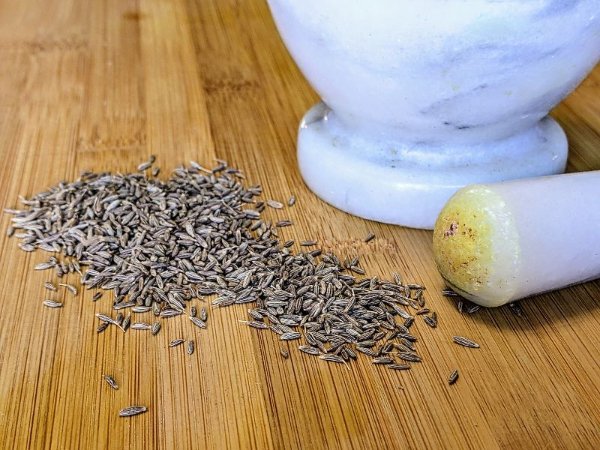
The spice cumin is made from the dried seed of the Cuminum cyminum plant which is a member of the parsley family. It is a popular spice and used quite commonly in Latin American, Middle Eastern, North African and Indian cuisines. It is available in whole seeds and ground form. What are cumin seeds, exactly.
Cumin seeds are small, long, oval shaped and resemble caraway seeds. They are also harvested by hand! The most common variety is yellowy-brown but there is a black, green and white varieties as well.
The origins of cumin go all the way back to ancient Egyptian times and has been found in excavations in Syria and ancient Egypt that are 4000 years old. In these times it was used as a spice and as an element to preserve mummies. Since these ancient times, cumin has been used extensively in India, as well as by Greeks and romans. It made its way to Mexico and South America after European colonization.
Cumin can be found whole, as a seed or ground as a powder. When used whole you want to add it to hot oil early on the cooking of the dish so that the flavour infuses the oil and then the rest of the ingredients. Lightly roasting the seeds brings out a more intense and nuanced flavour.
Cumin has a warm, earthy flavour with an aroma of both sweetness and bitterness. When storing cumin, the seeds can be kept in the freezer for a long time to maintain the flavour. Otherwise, the seeds can be stored in a cupboard for up to 3-4 years.
Cumin seeds, also known as Jeera, is very versatile. It is used in almost all part of Indian cooking. Including North Indian curries as well as the coconut curries of the south; vegetable delicacies of the West and also in the East.
Cumin seeds don’t look like much but they are very pungent with an aromatic flavour and a nutty-peppery taste. The cumin seed looks a lot like a caraway seed, long in shape with a yellowy-brown colour. The smell is very distinctive. It is early, pungent and slightly bitter but not hot.
There is also black cumin or kala jeera which are dark brown or black in colour and not as bitter or strong in flavour.
References
- https://www.healthline.com/nutrition/9-benefits-of-cumin
- https://www.medicalnewstoday.com/articles/319562
- https://www.webmd.com/vitamins/ai/ingredientmono-635/cumin
- https://www.mccormickscienceinstitute.com/resources/culinary-spices/herbs-spices/cumin
- My first time making scones - March 26, 2024
- Disappointing Visits to the Ripon and Plateau Farmers Markets - September 30, 2023
- The Ultimate Guide to Frozen Raw Dog Food: Benefits, Selection, and Transition Tips - September 25, 2023











